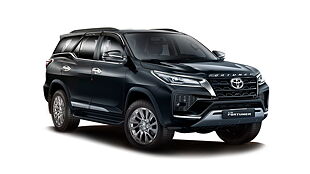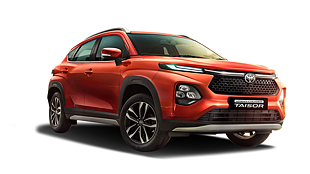Introduction

Not everybody wants a gargantuan, leather-stuffed SUV but at the same time, a typical people carrier that ticks all the practical boxes but lacks a little zing doesn’t do it for most of us either. Fortunately the market for utility vehicles has evolved big time, to the point where we now have options (Read: Tata Hexa, Toyota Innova Crysta) that straddle between SUVs and people-carriers, offering a bit of everything.
The Toyota Innova has commanded a staggeringly royal share of the full-size MPV segment for the past decade – selling nearly 72,000 units in 2016 alone. It’s the Innova, then, that is the biggest opponent to the tough-looking Tata Hexa and the stalwart it must beat here for the title of India’s best MPV.

Having tested and compared their manual gearbox-equipped versions (click here to read), we have chosen the six-seater, automatic Hexa and Innova for this twin test.
Cabin design, layout and features

Despite a fairly convincing makeover, the Innova Crysta looks like a traditional MPV than the Hexa, which deliberately aims to be different with its SUV-esque design cues. When it comes to road presence, the Hexa towers above the Innova and that heightened stance comes as an advantage once you’re seated in. More on this later…

There’s a clear gap between these two in terms of cabin design and layout. Whereas the Innova’s insides are full of horizontally layered surfacing and surprisingly lively looking trim bits, the Hexa makes use of clean and simple lines to frame its dash. The latter’s all-black cabin, in fact, features plenty of hexagonal chrome elements for the center vents, side vents and the infotainment system. The quality and feel of the gloss black finish and soft grain plastic is impressive too. What’s not so impressive though is the lack of storage spaces upfront for knickknacks. The only bit of storage comes in the form of a single cup holder behind the gear lever and underneath the front armrest. The glove compartment isn’t generously sized either.

Unsurprisingly, the Toyota’s front storage options are better thought out, with twin glove compartments, more volume underneath the armrest, plenty of storage bins in front of the gear lever and a pair of retractable cup holders on either side of the dash. The Innova is also better put-together - the buttons and dials have a tactile feel and the leather-wrapped steering wheel feels great to hold as well. In comparison, the top half of Hexa’s dashboard is finished in hard plastic that doesn’t match the soft door trim.

The Innova Crysta is better equipped of the two although that’s hardly an achievement given the huge price gap. Nonetheless, both come standard with climate control, electrically adjustable and retractable wing mirrors, automatic headlights, a touchscreen audio system with navigation, cruise control and instrument cluster with digital display. As for safety, the Hexa gets 6 airbags and ABS with EBD whereas the Innova comes with 7 airbags (additional airbag for driver’s knee) and ABS with EBD. What’s more, the Toyota gets keyless entry, start/stop button, foldable seatback table and electrically adjustable driver’s seat – features that are missing on the Hexa.
Seat comfort
Both the Hexa and the Innova have been designed to eat up kilometres. Naturally, they distance themselves from similarly priced sedans and crossovers when it comes to space and seat comfort.
Upfront, the Innova’s seats position you more upright than the Hexa’s that tend to sink you into the cabin. Despite this, one tends to sit a little higher in the Tata. Ergonomically, the Innova pips the Hexa by a tiny margin – its air-con and music system controls are stacked higher up the dash and easier to use and the driving position is comfier too – the Hexa’s steering is a little too close to the driver.

In this six-seater configuration, both get captain seats for the middle row and inhere it’s the Hexa’s well-cushioned and supportive seats that are noticeably more comfortable than the ones in the Innova. In fact, the Innova’s middle row is surprisingly flat with little in terms of contours. Those seated in the back of the Hexa will also appreciate the additional headroom on offer.

The Hexa also betters the Innova as you move onto the third row. Compared to the Innova, there is more knee space and bigger windows for that airy feeling. However, we noted that curtain airbags do not extend all the way to the third row like they do in the Innova. Overall, the Hexa scores well with its plush seating but ergonomically it falls back a little – the captain seats do not completely tumble down, meaning getting into the third row is bit of a squeeze. The boot space, too, isn’t as usable as the Innova’s as the third row doesn’t fold completely flat.

Road manners

On paper there are considerable differences between the two. Whereas the Hexa gets a 156bhp/400Nm 2.2-litre motor, the Innova Crysta features a much bigger 2.8-litre unit with 174bhp/360Nm. As for the crux of this test, both engines are paired to a 6-speed automatic gearbox.
Unlike the manual Hexa which feels lethargic and heavy below 2,000rpm, this automatic version makes driving in the city a lot easier – the bottom-end is way more responsive as the 6-speed auto, with its shorter gearing, eliminates most of the turbo lag. The gearshifts itself are silky smooth and conveniently timed around the meaty portion of the power band. Speaking of which, the Hexa pulls strongly between 2,000 and 3,500rpm although what really impresses is the fact that it remains nearly this strong all the way to the redline – a rarity in big displacement diesel engines.

The still noticeable turbo lag is the only downside to the Hexa’s otherwise impressive drivetrain which is much quieter and stronger at top-end where the Innova can get loud and boomy. That said, the Innova always feels more effortless to get up to speed and is more responsive overall, too, as confirmed by our timing gear. The Innova does 0-100kmph in 11.67 seconds, compared to 12.67 seconds for the Hexa. Our tests show that it’s quicker under roll-on acceleration as well, completing 40-100kmph and 20-80kmph (in kick-down) roughly a second before the Hexa. The Toyota’s 6-speed automatic is as quick as the Tata’s unit; however, it isn’t as smooth especially when going down the gears. The former also has this tendency to coast as soon as you lift off the throttle which can be bothersome for some when going downhill.

As for the steering feel and ride quality, the Innova is more manageable when you are puttering around town. Its steering is lighter and more direct than the Hexa which weighs up inconsistently as you apply more lock. The Hexa also feels top heavy as you chuck it around the corners, unlike the Innova which behaves relatively car-like.
Low speed ride on both these vehicles are closely matched; they remain composed over uneven patches but tend to be upset by sharp potholes. The Hexa’s massive tyres, in particular, snag on sharp-edged potholes, affecting the otherwise nicely balanced damping. Up the pace however and differences begin to appear. At higher speeds, the Hexa settles itself quickly and ploughs on over whatever you point it at. There’s inherent composure to its heavy chassis that will surely give the driver great sense of control behind the wheel. The Innova, on the other hand, starts to lope and pitch over the same bumps and is disturbed by roads that don’t cause the Hexa to break a sweat.

In terms of fuel efficiency, the Innova just about beats the heavier Hexa. In our tests, the Hexa managed 9.5kmpl in the city and 13.2kmpl on the highway. Meanwhile, the Innova fared slightly better at 9.8kmpl and 13.9 kmpl respectively.
Verdict

Rank 2
Tata Hexa XTA 4X2
Final Score: 379/600
Price: Rs 21.56 lakh (on-road, Mumbai)
Pricing gets the Tata Hexa off to a strong start. At Rs 21.56 lakh on-road, it’s nearly Rs 5 lakh cheaper than the mighty Innova Crysta. The Hexa, then, is good value and a real charmer in many ways. It’s got strong road presence, excellent ride quality and proper comfort levels for six adults. Add to that its hushed cabin and capable drivetrain and the Hexa makes for an ideal buy for those who end up doing frequent long-distance trips. Although its heaps more enticing proposition than the Aria ever was, the Hexa cannot quite match the Innova Crysta on many fronts including outright performance, build quality and most importantly, brand value.

Rank 1
Toyota Innova Crysta 2.8 ZX AT
Final Score: 387/600
Price: Rs 26.61 lakh (on-road, Mumbai)
In the final reckoning, it’s the Innova Crysta that wins this test. It may not be as car-like to drive as it used to be and it remains a little too noisy, but its strong engine/responsive auto box, better build quality and usable interior means the Innova Crysta will serve its duties better than ever before. Being a Toyota, the Innova also has significantly better ownership credentials than its recently launched contender and that alone is enough to sway the verdict. If only Toyota would fix the choppy high speed ride.
Specification
| CAR NAME | Toyota Innova Crysta | Tata Hexa |
| Variant | ZX 2.8 AT | XTA 4x2 A/T VARICOR 400 |
| ENGINE | ||
| Fuel | Diesel | Diesel |
| Installation | Front, transverse | Front, transverse |
| Displacement | 4 cyls, 2795cc | 4 cyls, 2179cc |
| Power | 174bhp at 3400rpm | 156bhp at 4000rpm |
| Torque | 360nm at 1200-3400rpm | 400Nm at 1700-2700rpm |
| Power to weight | 93.04bhp per tonne | 69bhp per tonne |
| Torque to weight | 192.51Nm per tonne | 176.82Nm per tonne |
| Gearbox | 6-speed automatic | 6-speed automatic |
| CHASSIS & BODY | ||
| Kerb weight | 1880kg | 2170kg |
| Tyres | 215/55 R17 | 235/55 R19 |
| Spare | Full-size | Full-size |
| STEERING | ||
| Type | Rack and pinion | Rack and pinion |
| Type of assist | Hydraulic | Hydraulic |
| Turning circle | 10.80m | 11.50m |
| BRAKES | ||
| Front | Discs | Discs |
| Rear | Drums | Discs |
| Anti-lock | Yes | Yes |
Test Data
| CAR NAME | Toyota Innova Crysta | Tata Hexa |
| Variant | ZX 2.8 AT | XTA 4x2 A/T |
| PERFORMANCE & BRAKING | ||
| 0-20kmph | 1.01s | 0.94s |
| 0-40kmph | 2.69s | 2.67s |
| 0-60kmph | 4.81s | 4.97s |
| 0-80kmph | 7.74s | 8.30s |
| 0-100kmph | 11.67s | 12.67s |
| 0-120kmph | 16.63s | 18.70s |
| 20-80kmph in 3rd gear (kickdown) | 6.73s | 7.49s |
| 40-100kmph in 4th gear (kickdown) | 8.56s | 9.73s |
| 80-0kmph | 25.45m | 25.97m |
| FUEL ECONOMY | ||
| City | 9.80kmpl | 9.50kmpl |
| Highway | 13.90kmpl | 13.20kmpl |
| Tank size | 55 litres | 60 litres |
| Range | 556km | 582km |
| INTERIOR MEASUREMENTS | ||
| Front | ||
| Legroom(Max/min) | 820/610mm | 790/570mm |
| Headroom | 1020mm | 1000mm |
| Shoulder room | 1460mm | 1450mm |
| Backrest height | 630mm | 650mm |
| Rear | ||
| Legroom(Max/min) |
1010/760mm |
960/740mm |
| Ideal legroom | 830mm | 790mm |
| Headroom | 1020mm | 990mm |
| Shoulder room | 1460mm | 1460mm |
| Seat base length | 490mm | 520mm |
| Backrest height | 630mm | 600mm |
| Boot | - | 540 litres |
| Length/width/height | 1210/1270/640mm | 850/1200/480mm |
| Loading lip height | 710mm | - |
Score Sheet
| Parameters | Max points |
Toyota Innova Crysta |
Tata Hexa |
| DRIVING FEEL | |||
| Steering response | 20 | 9 | 9 |
| Directional stability | 25 | 14 | 14 |
| Engine characteristics | 25 | 17 | 17 |
| Gearbox | 20 | 13 | 15 |
| Visibility | 10 | 7 | 7 |
| Intermediate results | 100 | 58 | 62 |
| SPACE | |||
| Front Space | 25 | 20 | 18 |
| Rear space | 25 | 18 | 19 |
| Feeling of space | 20 | 16 | 16 |
| Boot space/flexibility | 20 | 20 | 18 |
| Payload | 10 | 7 | 7 |
| Intermediate results | 100 | 81 | 78 |
| IN THE CABIN | |||
| Comfort equipment | 25 | 16 | 12 |
| Operatibility | 15 | 11 | 10 |
| Feel of quality | 20 | 12 | 13 |
| Front seats/ingress | 20 | 16 | 18 |
| Rear seat/ingress | 20 | 15 | 17 |
| Intermediate results | 100 | 70 | 70 |
| PERFORMANCE | |||
| Acceleration | 25 | 17 | 16 |
| Top speed | 10 | 8 | 7 |
| Driveability | 30 | 24 | 21 |
| Braking | 25 | 21 | 20 |
| Environment | 10 | 5 | 5 |
| Intermediate results | 100 | 75 | 69 |
| ROAD MANNERS | |||
| Ride quality | 30 | 20 | 23 |
| Turning circle | 15 | 12 | 12 |
| Handling | 20 | 10 | 9 |
| Manoeuvrability | 15 | 8 | 8 |
| Safety | 20 | 12 | 9 |
| Intermediate results | 100 | 62 | 61 |
| PRICE | |||
| Price | 45 | 8 | 10 |
| Resale | 10 | 8 | 6 |
| Warranty | 10 | 7 | 8 |
| Fuel efficiency | 35 | 16 | 15 |
| Intermediate results | 100 | 39 | 39 |
| Total | 600 | 387 | 379 |

![Toyota Innova Crysta [2016-2020] Image Toyota Innova Crysta [2016-2020] Image](https://imgd.aeplcdn.com/272x153/n/cw/ec/20623/innova-crysta-exterior-right-front-three-quarter.jpeg?q=80)

























